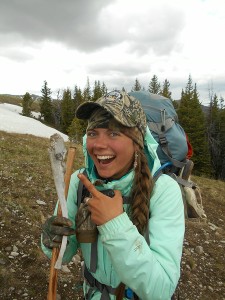 As we reached 9800 feet in the Snowcrest Mountains our group of seven was exhausted from a long day of backpacking. With stomachs growling, our feet were blistered and exhaustion had almost overcome us. Despite all of this we took a minute to look around. Immediately spectacular views lifted our spirits. Long ridge lines, snowcapped talus, slopes and saddles backs covered in wildflowers. Deep valleys covered with sage and filled with lakes and rivers juxtaposed the mountain peaks reaching towards the clouds. Only the skeletons of white bark pines could mar such a fantastic view. These trees have been faced with attacks from all angles, a fungus called blister rust, a beetle, and periods of draught. Many things play into the mass die off of white bark pines, with increasing temperatures at higher altitudes due to climate change the tree are less able to fight off the beetle and fungus.
As we reached 9800 feet in the Snowcrest Mountains our group of seven was exhausted from a long day of backpacking. With stomachs growling, our feet were blistered and exhaustion had almost overcome us. Despite all of this we took a minute to look around. Immediately spectacular views lifted our spirits. Long ridge lines, snowcapped talus, slopes and saddles backs covered in wildflowers. Deep valleys covered with sage and filled with lakes and rivers juxtaposed the mountain peaks reaching towards the clouds. Only the skeletons of white bark pines could mar such a fantastic view. These trees have been faced with attacks from all angles, a fungus called blister rust, a beetle, and periods of draught. Many things play into the mass die off of white bark pines, with increasing temperatures at higher altitudes due to climate change the tree are less able to fight off the beetle and fungus.
Climate change carries a very negative connotation, and rightfully so. It is a topic surrounded by conflict, hopelessness, confusion, and passion. This is the biggest challenge our generation will face on a global and local scale and I believe that to begin addressing climate change, we need to accept that change will happen and find ways to adapt to it. Adaptation is crucial because we are already facing imminent changes, As a part of accepting it we need to see climate change in a new light, we need to find the silver lining. When it comes to the white bark pine it is easy to fall into despair, but there are two things that have accompanied this loss that may provide opportunities for hope. First, we witnessed a wood peckers going in search of these beetles for food. They excavate nests in these snags. Once the wood peckers abandon these nest many other birds can make there homes there. A system of exchange between species over time like this is known as a trophic cascade. Second, as we looked out across a sea of dead snags there were a few dark green white bark pines that had not suffered the same fate. Those white bark pines with enough genetic variation to survive may open a door to hope for their species. The trophic cascade coupled with the few lone survivors may indicate that these ecosystems may be able to adapt. Although the ecosystem may shift in terms of its functions and appearance it may be able to rebound and recreate its self.
The example of the white bark pines provides a solid platform to relate this all back to humans. Much as the wood pecker takes advantage of the beetles and the dead snags so will people need to take advantage of new developments that accompany climate change. The few survivors show us that just a few new ideas can provide hope for the future. That is not to say that throwing in the towel in terms of mitigating climate change is the solution, but adaptation should accompany mitigation. Facing climate change will not be easy, but by utilizing acceptance and adaptation it is possible for us and the ecosystems around us to not only survive but also thrive.